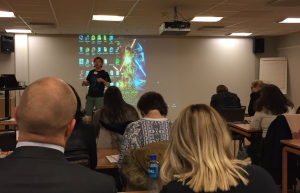
On November 26th I attended conference at Vika Atrium in Oslo, where I did a presentation of IBM Connections. I also got to see several presentations of Intranet solutions from other companies, as well as gaining some insights on where intranets are going now. Because an intranet is no longer just a web page.
Development
When intranets were introduced at the end of the 90s they started as static web pages where management provided information for their employees. After a while it also turned into a portal, where you could find links to other internal systems and resources.
But when social tools like Facebook really started to make an impact, it became clear that an intranet like that wasn’t very valuable. It was just a static web site which nobody would read. This prompted companies to develop intranets that were more interactive. The content wasn’t just produced by management any more, it also started to become more user generated.
This lead to some changes:
- Leaders started to blog and gave their employees the possibility to comment, ask questions and reply
- Instead of just sending out information about events, happenings and news, the employees could take more control of the flow of information
- The intranet wasn’t just a news site any more. It became more like a dash board, or control panel, where employees start their working day
As the evolution of the intranets and social tools went on, the intranet now turned into a repository where all the flow of information, documentation and other communication took place, and were stored. And that’s when users started to demand the possibility of using the intranet on their phones and pads. So now the trend is that an intranet project also includes development of an app for mobile devices.
In my company
In my job, we are somewhere inbetween a full social intranet and an old fashioned intranet. Our intranet solution is now four years old, and it has severely cut down on internal emails sent out to all (that almost never happens any more). But the communication on the intranet itself is very one sided. That’s where IBM Connections comes in.
IBM Connections gives us a news stream, the possibility to upload and share files with full version control, to share bookmarks, to create complete wikis with documentation and information, to move discussions to forums instead of emails and plugins that makes it possible to work with content directly from Microsoft Office, Windows Explorer and IBM Notes (or Outlook if you use that as your email client). All the content have version control, can be commented on and, yes, even “liked.” By tagging content it becomes much easier to find when searching for it.
We also have blogs, and our CEO is blogging several times a year to give us a summary of our company’s situation. People can then comment, ask questions directly.
The process of adapting to Connections is still going on, and I’m in charge of the training. But we are seeing the fruits of the process now. Files that used to be hidden on network drives are now much easier to find (and it has access control). More and more people are now asking questions and have discussions in open forums instead of using email, where only the “lucky” ones that are included in the “to” or “cc” field can take part. We also have projects and processes where communications and sharing of information and documentations now happen in communities, instead of being hidden away.
In that regard, IBM Connections is now a part of our intranet, at least if we use the definition of a modern intranet. And it will in the long run be our complete intranet. I’m currently testing out using the news stream from IBM Connections to create a standard startup page that will open when you log on in the morning. It will consist of official news streams that you can’t remove. But it will also be possible for the users to have control of what they want to see and not.
And since IBM Connections has a complete mobile app, both for Apple devices and Android devices, we have that covered as well.
My presentation
In addition to touching on the ideas mentioned above, I also gave a live demo of IBM Connections, directly from our servers. I demonstrated both the web edition, the mobile edition and how the plugins work.
What was funny was that I could present functionality that other companies in the room had spent millions on. Not, that’s not right: They had spent millions and still had only half of the functionality I presented. I was asked on how much development cost we had on it, and I could say: – None!
It all comes out of the box. You only need to purchase the licenses for Connections, and get it up and running. That’s it. You can do development on it since it has a very open and well documentet API. But if you want to you can just start using it. And: The mobile app is included. You will have no development costs for a mobile version of your intranet.
I got great feedback from people after my presentation was over, and I have received a couple of emails afterwards where people have told me that they wished IBM could be this good at selling their own solutions. Personally I just like presenting things I like to use, but I should really get a commission from IBM for this, shouldn’t I? 🙂